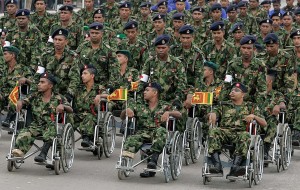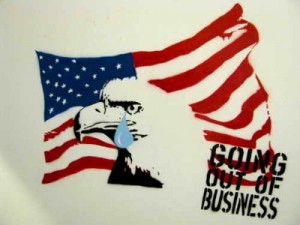The American War That Nobody Has Heard Of
On August 3, 2006, the Liberation Tigers of Tamil Eelem (LTTE),slaughtered over 100 Muslim civilians including women and children at Pachchanoor, Sri Lanka. Before then, the LTTE butchered 103 Muslims while they wre praying in the grand mosque of Kattankudiy in the coastal city of Batticaloa. You can see the images of these attacks here. It is not pretty. The Tamils had no cause to fight the Muslims, their grievances – imagined or real – were directed at the Sinhalese majority. The LTTE, however, and its leader, Vellupillai Prabhakaran, were committed to the matter of ethnic cleansing in the North. The attacks on the Muslims were part of that effort which also left entire villages of Sinhalese peasants murdered in cold blood in a war that lasted thirty years.
These are events that merit mentioning given the current effort by the United States to table a resolution alleging that the Sri Lankan government perpetrated war crimes during the last days of the war. For the past week there have  been demonstrations at the Hague by pro-LTTE groups alleging that the Sri Lankan government set out to kill the Tamil civilians trapped between the army and the terrorists (The LTTE has been referred to by the FBI as the most ruthless terrorist organization in the world and it was banned, albeit only after 9/11, by the
been demonstrations at the Hague by pro-LTTE groups alleging that the Sri Lankan government set out to kill the Tamil civilians trapped between the army and the terrorists (The LTTE has been referred to by the FBI as the most ruthless terrorist organization in the world and it was banned, albeit only after 9/11, by the  US and the UK). It is an easy thing to imagine: a government out of patience with repeated ceasefires and the interventions of foreign governments committed to speaking on behalf not of Tamils but of the LTTE, sets out to murder all the Tamils in the North (the 54% of the Tamils who live outside the North and East were, presumably, safe, odd as that may sound given the allegations).
US and the UK). It is an easy thing to imagine: a government out of patience with repeated ceasefires and the interventions of foreign governments committed to speaking on behalf not of Tamils but of the LTTE, sets out to murder all the Tamils in the North (the 54% of the Tamils who live outside the North and East were, presumably, safe, odd as that may sound given the allegations).
Except that it isn’t true. Civilians died, yes, though not in as great a number as they did in Iraq, Afghanistan and Pakistan at the hands of the United States military. But not only was there no massacre of all the civilians trapped in the North, most of them, over 100,000, were rescued between April 20th and April 22nd, 2009, from the LTTE which fired on them and placed a suicide bomber among them as they tried to reach the refugee camps.
Sri Lanka fought this war for thirty years against the interference of powerful foreign groups, and in the midst of a tsunami  that devastated the country, leaving 40,000 dead and 1.5 million people displaced, and the struggles of a small country caught in a failing global economy. It fought this war against a terrorist organization while, simultaneously, providing the entire civilian population controlled by the LTTE (as well as LTTE cadres), with water, electricity, infrastructure, education, and all forms of social welfare available to the rest of the island, including food and medicine. This has to be a first for any government in the world.
that devastated the country, leaving 40,000 dead and 1.5 million people displaced, and the struggles of a small country caught in a failing global economy. It fought this war against a terrorist organization while, simultaneously, providing the entire civilian population controlled by the LTTE (as well as LTTE cadres), with water, electricity, infrastructure, education, and all forms of social welfare available to the rest of the island, including food and medicine. This has to be a first for any government in the world.
The war in Sri Lanka ended in May, 2009. Since then, the economy is thriving with unprecedented investment  in infrastructure from the South to the North. Sri Lanka instituted the Lessons Learned and Reconciliation Committee (LLRC), and conducted hearings in the immediate aftermath of the war. The Government of Sri Lanka is engaged in implementing the recommendations of the LLRC, despite being blamed for being “slow.”
in infrastructure from the South to the North. Sri Lanka instituted the Lessons Learned and Reconciliation Committee (LLRC), and conducted hearings in the immediate aftermath of the war. The Government of Sri Lanka is engaged in implementing the recommendations of the LLRC, despite being blamed for being “slow.”  Consider that we were willing to wait for two years of hearings to be completed by the Truth and Reconciliation Commission (between 1996 and 1998) in South Africa. Consider that we were willing to wait four more years, until 2002, until the last of the reports from that commission were presented to the President.
Consider that we were willing to wait for two years of hearings to be completed by the Truth and Reconciliation Commission (between 1996 and 1998) in South Africa. Consider that we were willing to wait four more years, until 2002, until the last of the reports from that commission were presented to the President.
It is politics. Geo-politics. Always. A country with a president who watched its military murder a terrorist-leader, Osama bin Laden, in cold blood after having violated all rules of sovereignty in Pakistan, then disposed of that body out of public view, hardly has a moral leg to stand on when it comes to decrying the death of a terrorist leader who was killed in a final battle at the end of thirty years of war that held a country hostage. This resolution is not about Sri Lanka, it is a play by the US for power in South Asia, a play that is causing the US to call in every favor they’ve ever been promised, and includes the investment of millions of dollars in buying-off and buying-up.
Which brings me back to those Muslims. The LTTE was a group that, repeatedly, demonstrated a particularly virulent hatred for Sri Lanka’s Muslim population, a minority group that has always remained within the democratic system, a group that has never, not once, in the history of that nation, ever perpetrated crimes against their fellow citizens. Pakistan recognizes this as do other Muslim nations. Can the United States, in the wake of riots after the burning of copies of the Quo’ran and the murder of 16 Afghan civilians by Robert Bales, not to mention its decade long occupation of Iraq and years of invading Afghanistan and the drone strikes on innocents in Pakistan, including 160 children between 2004 and the end of 2011, afford to align itself with yet another anti-Muslim organization? Particularly one that is proscribed by its own state department?
Sri Lanka has many friends. Sri Lanka is also a predominantly Buddhist country, used to thinking about the evolution of events in terms of lifetimes, not a 24 hour news-cycle. Whether they win or lose in Geneva, Sri Lanka will endure.  The coordinates are different for an America struggling to hold on to a semblance of relevence on the world scene. In a time when the Muslims are out in force against the United States – Pakistan, Aghanistan, Iran, Iraq and Palestine, are but five – the United States has but one democracy it can count on as an ally: Sri Lanka. India has, under internal pressure, expressed its support for the US, thereby alienating the second largest population of Muslims in the world, its own. Today, the Muslim population of Sri Lanka joined the ranks of their brothers and sisters in the rest of South Asia to protest the actions of the United States.
The coordinates are different for an America struggling to hold on to a semblance of relevence on the world scene. In a time when the Muslims are out in force against the United States – Pakistan, Aghanistan, Iran, Iraq and Palestine, are but five – the United States has but one democracy it can count on as an ally: Sri Lanka. India has, under internal pressure, expressed its support for the US, thereby alienating the second largest population of Muslims in the world, its own. Today, the Muslim population of Sri Lanka joined the ranks of their brothers and sisters in the rest of South Asia to protest the actions of the United States.
It is governments that control airspace, ports, resources and investments. Not terrorist groups. And the Sri Lankan government will turn with great ease toward China and toward its allies in the Muslim world. The last thing that the US needs is to provide further proof that it is, by policy, military exercises and deliberate intent, anti-Muslim. It is not time for a resolution against Sri Lanka. It is time for the Obama administration to rethink its strategy.
Note: The photographs above depict, in order, former female members of the LTTE, former child soldiers recruited by the LTTE (original photograph first appeared in the Washington Times), injured Sri Lankan soldiers on parade, Sri Lankan child post-war, Archbishop Desmond Tutu and de Klerk after the end of apartheid and a graffiti version of the American flag)


Wow..I’m surprised to read your article. In a world where government doesn’t have support of CNN and other big media, article like yours give such encouragement to people of Sri Lanka. I think US policy adapted by US State Dept South Asian Head & former SL Ambassador is misguiding Obama administration. If US wants to engage SL, first US need to fire Blake from his current position and get someone with much broader view and respect to Sri Lanka. In this country people live harmony and you need to come and experience it.
execllent Ru…”WHether we win or loose in Geneva Sri Lanka will endure”..!
Do you get paid to write this?
Ha! I wish!!!